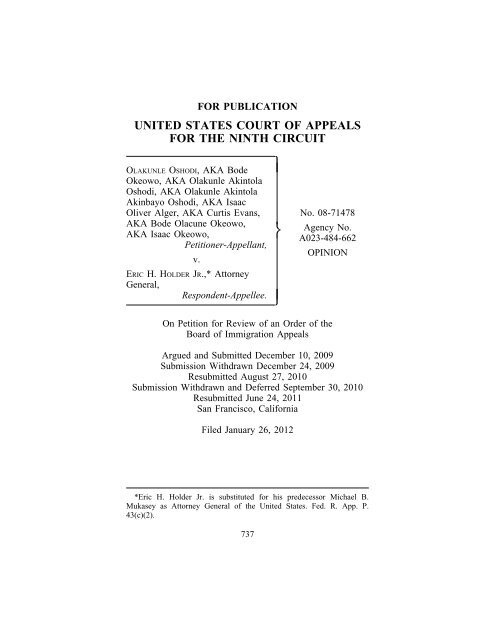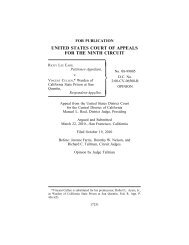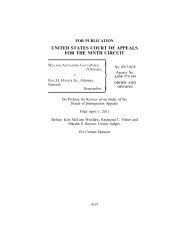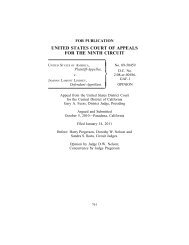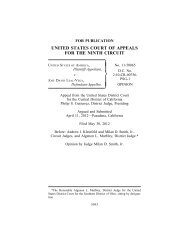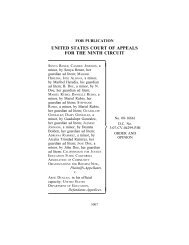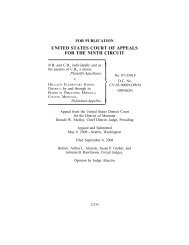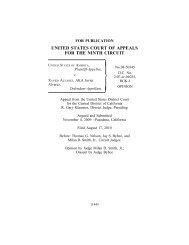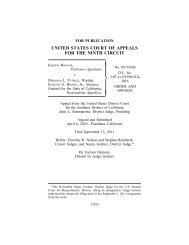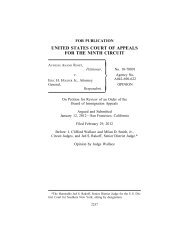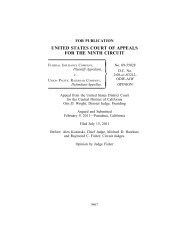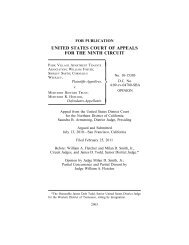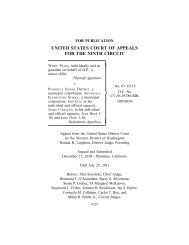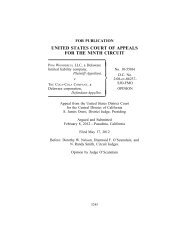olakunle oshodi v. eric h. holder jr. - Ninth Circuit Court of Appeals
olakunle oshodi v. eric h. holder jr. - Ninth Circuit Court of Appeals
olakunle oshodi v. eric h. holder jr. - Ninth Circuit Court of Appeals
Create successful ePaper yourself
Turn your PDF publications into a flip-book with our unique Google optimized e-Paper software.
FOR PUBLICATION<br />
UNITED STATES COURT OF APPEALS<br />
FOR THE NINTH CIRCUIT<br />
OLAKUNLE OSHODI, AKA Bode<br />
Okeowo, AKA Olakunle Akintola<br />
Oshodi, AKA Olakunle Akintola<br />
Akinbayo Oshodi, AKA Isaac<br />
Oliver Alger, AKA Curtis Evans, No. 08-71478<br />
AKA Bode Olacune Okeowo,<br />
Agency No.<br />
AKA Isaac Okeowo,<br />
A023-484-662<br />
Petitioner-Appellant,<br />
OPINION<br />
v.<br />
ERIC H. HOLDER JR.,* Attorney<br />
General,<br />
Respondent-Appellee.<br />
On Petition for Review <strong>of</strong> an Order <strong>of</strong> the<br />
Board <strong>of</strong> Immigration <strong>Appeals</strong><br />
Argued and Submitted December 10, 2009<br />
Submission Withdrawn December 24, 2009<br />
Resubmitted August 27, 2010<br />
Submission Withdrawn and Deferred September 30, 2010<br />
Resubmitted June 24, 2011<br />
San Francisco, California<br />
Filed January 26, 2012<br />
*Eric H. Holder Jr. is substituted for his predecessor Michael B.<br />
Mukasey as Attorney General <strong>of</strong> the United States. Fed. R. App. P.<br />
43(c)(2).<br />
737
738 OSHODI v. HOLDER<br />
Before: Diarmuid F. O’Scannlain, and Johnnie B. Rawlinson,<br />
<strong>Circuit</strong> Judges, and Robert E. Cowen,**<br />
Senior <strong>Circuit</strong> Judge.<br />
Opinion by Judge Rawlinson<br />
**The Honorable Robert E. Cowen, Senior United States <strong>Circuit</strong> Judge<br />
for the Third <strong>Circuit</strong>, sitting by designation.
740 OSHODI v. HOLDER<br />
COUNSEL<br />
Petitioner Olakunle Oshodi is represented by Leon Fresco,<br />
Marlysha Myrthil, and Christopher Nugent (argued), Holland<br />
& Knight, LLP, Jacksonville, Florida.<br />
Respondent Attorney General Eric H. Holder Jr. is represented<br />
by Michael F. Hertz, Acting Assistant Attorney General,<br />
Civil Division; Anh-Thu P. Mai-Windle, Senior<br />
Litigation Counsel; and Imran R. Zaidi, Trial Attorney<br />
(argued), Office <strong>of</strong> Immigration Litigation, United States<br />
Department <strong>of</strong> Justice, Washington, D.C.<br />
RAWLINSON, <strong>Circuit</strong> Judge:<br />
OPINION<br />
Olakunle Oshodi petitions this court for review <strong>of</strong> a decision<br />
by the Board <strong>of</strong> Immigration <strong>Appeals</strong> (BIA) affirming<br />
the immigration judge (IJ), who made an adverse credibility<br />
determination and denied Oshodi’s requests for withholding<br />
<strong>of</strong> removal and relief pursuant to the Convention Against Torture<br />
(CAT). 1<br />
We have jurisdiction pursuant to 8 U.S.C. § 1252, and we<br />
deny the petition for review.<br />
1 Oshodi does not appeal the IJ’s denial <strong>of</strong> his asylum claim.
I. BACKGROUND<br />
OSHODI v. HOLDER<br />
A. Oshodi’s Asylum Application<br />
Oshodi, a citizen <strong>of</strong> Nigeria, requested asylum, withholding<br />
<strong>of</strong> removal, and protection under CAT based on his fear <strong>of</strong><br />
persecution and torture due to his religion and political opinions.<br />
In his declaration, Oshodi stated that his mother was killed<br />
in 1968 by “anti-democratic <strong>of</strong>ficers” because <strong>of</strong> her political<br />
activities. When Oshodi was sixteen he joined the National<br />
Association <strong>of</strong> Nigerian Students (NANS), a group that<br />
opposed the security forces, and when he returned to Nigeria<br />
in 1981, he joined the Unity Party <strong>of</strong> Nigeria (UPN), a group<br />
that opposed the government and security forces.<br />
Oshodi described three incidents <strong>of</strong> persecution. First,<br />
Oshodi attended a rally against the government and was<br />
beaten by police, but escaped arrest. Second, in February,<br />
1981, Oshodi and his friend drove through a police checkpoint<br />
after the police saw “political propaganda.” According<br />
to Oshodi, the police shot at the car and hit Oshodi’s friend,<br />
who died eight days later. The police detained and tortured<br />
Oshodi for two days until his uncle paid for his release.<br />
Thereafter, an open warrant was issued against Oshodi for<br />
failing to report for weekly monitoring. Third, on February<br />
17, 1981, the police arrested Oshodi after he dropped a party<br />
member <strong>of</strong>f at the airport. The police drove Oshodi to an<br />
unknown location where he was “shot in the foot, burnt with<br />
cigarettes, elctric [sic] shocked, beaten with swagger canes,<br />
pistol and riffle [sic] whipped, stripped nude” and sodomized<br />
with “swagger canes” and “dirty bottles”. After this incident,<br />
Oshodi returned to the United States.<br />
B. Pr<strong>of</strong>essor Mitchell’s and Oshodi’s Testimony<br />
741<br />
Pr<strong>of</strong>essor Mitchell, a Nigerian expert, testified that “a<br />
member <strong>of</strong> NANS who has been in political exile and who is
742 OSHODI v. HOLDER<br />
regarded as being an opponent <strong>of</strong> the Nigerian government<br />
would likely be detained and tortured should he be returned.”<br />
Pr<strong>of</strong>essor Mitchell noted that a member <strong>of</strong> the UPN “wouldn’t<br />
have nearly the same difficulty he would be [sic] as a member<br />
<strong>of</strong> NANS”, but that it would be “horrific” for Oshodi to return<br />
to Nigeria based on “the treatment <strong>of</strong> people who have been<br />
in detention, especially who return under those circumstances<br />
under a warrant . . .” When questioned about Oshodi’s father,<br />
Pr<strong>of</strong>essor Mitchell stated that he “could be mistaken”, but he<br />
believed Oshodi’s father was living in “southern California”.<br />
When Oshodi began to testify regarding his political<br />
involvement and the political rally he attended, the IJ told<br />
Oshodi he had read Oshodi’s application and did not need<br />
Oshodi’s testimony “line by line”. Oshodi then testified about<br />
his political activities, and that he believed he would “be tortured,<br />
detained, [and] most likely killed” if he returned to<br />
Nigeria.<br />
During cross-examination, Oshodi stated that his father was<br />
deceased, and that he signed the sworn statement stating that<br />
his father was involved in politics instead <strong>of</strong> his “granddad”<br />
because he was rushed. When asked about why his name was<br />
not on the deed to the Nigerian property he said was confiscated,<br />
Oshodi answered that the “deed never transferred to<br />
[his] name”, but he paid taxes on the property and received<br />
income from it.<br />
On re-direct examination, Oshodi explained that he used<br />
aliases to “hide [his] identity from Nigerians”, and that his<br />
last name is well known in Nigeria. When questioned by the<br />
IJ, Oshodi stated that his father had been “back and forth”<br />
from Nigeria, that he only listed three siblings on his application<br />
because “some <strong>of</strong> [his siblings] are half brothers”, and<br />
that Larry, his half-brother, was in court during the removal<br />
proceedings, but did not submit a statement to the court.
OSHODI v. HOLDER<br />
C. The IJ’s and BIA’s Decisions<br />
743<br />
The IJ determined that Oshodi was not credible. The IJ<br />
concluded that Oshodi’s “acknowledged use <strong>of</strong> made up false<br />
names all cast doubt upon his forthrightness.” The IJ also<br />
relied on the fact that Oshodi complained that a “substantial<br />
amount <strong>of</strong> his property was confiscated in Nigeria”, but later<br />
“admitted that the properties were not in his name and that the<br />
deed was never transferred.” The IJ further noted that Oshodi<br />
failed “to satisfactorily explain whether his father was living<br />
or deceased.” Oshodi also stated in a sworn statement to<br />
immigration authorities that he feared harm in Nigeria<br />
because <strong>of</strong> his “dad”, but then later testified that he said<br />
“granddad” and that the discrepancy was due to being rushed<br />
into signing the document without reading it.<br />
The IJ observed that there “were also notable omissions<br />
and discrepancies between [Oshodi’s] application and his testimony”<br />
regarding his siblings. Namely, Oshodi only listed<br />
three out <strong>of</strong> ten siblings on his application. He attempted to<br />
explain the omission by asserting that he thought he was supposed<br />
to put full siblings on the application despite the fact<br />
that two <strong>of</strong> the three siblings were half-siblings.<br />
The IJ further noted that Oshodi “claimed that his father<br />
had regularly come and gone from Nigeria”, which undermined<br />
Oshodi’s claim that “he would be identified and<br />
detained in Nigeria because <strong>of</strong> his name.” The IJ also<br />
observed that Oshodi’s brother was sitting in court during the<br />
entire proceeding and failed to testify or submit an affidavit<br />
to corroborate Oshodi’s claims. The IJ concluded that Oshodi<br />
should have “provid[ed] evidence that corroborat[ed his] testimony”<br />
and denied Oshodi’s requests for asylum, withholding<br />
<strong>of</strong> removal, and relief under the CAT. 2<br />
2 The IJ admitted a substantial amount <strong>of</strong> evidence, including the following:<br />
Oshodi’s testimony; Oshodi’s asylum application and supporting declaration;<br />
a police record from this country; a medical report; a psychiatric
744 OSHODI v. HOLDER<br />
The BIA upheld the IJ’s adverse credibility determination<br />
and dismissed Oshodi’s appeal. Oshodi then petitioned this<br />
court for review, and we remanded the case to the BIA to analyze<br />
and consider: “a) the impact <strong>of</strong> the REAL ID Act on the<br />
BIA’s finding that petitioner’s claims for relief and protection<br />
were not sufficiently corroborated; b) the legislative history <strong>of</strong><br />
the REAL ID Act’s credibility provisions, and its impact upon<br />
the immigration Judge’s [sic] credibility determination; and c)<br />
any other issues the BIA deems appropriate to address if it<br />
chooses to permit further briefing from counsel.”<br />
On remand, the BIA concluded that the REAL ID Act codified<br />
the BIA’s corroboration requirements and that Oshodi<br />
failed to provide corroborating evidence. The BIA further<br />
considered the fact that the REAL ID Act changed the “heart<br />
<strong>of</strong> the claim” analysis to a “totality <strong>of</strong> the circumstances”<br />
analysis and found “no clear error in the Immigration Judge’s<br />
adverse credibility finding . . .” Oshodi filed a timely petition<br />
for review.<br />
II. STANDARD OF REVIEW<br />
“The decision that an alien has not established eligibility<br />
for asylum or withholding <strong>of</strong> removal is reviewed for substantial<br />
evidence.” Malkandi v. Holder, 576 F.3d 906, 912 (9th<br />
Cir. 2009), as amended (citation and internal quotation marks<br />
omitted). “Under the substantial evidence standard, administrative<br />
findings <strong>of</strong> fact are conclusive unless any reasonable<br />
adjudicator would be compelled to conclude to the contrary.”<br />
Id. (citation and internal quotation marks omitted).<br />
evaluation report; letters from Oshodi’s family; and country conditions<br />
reports. The IJ admitted the following evidence for identification purposes<br />
only due to a lack <strong>of</strong> authentication: Nigerian police reports; Oshodi’s<br />
1981 hospital report; Oshodi’s mother’s 1968 death certificate; Oshodi’s<br />
real estate documents; and Oshodi’s relatives’ letters regarding his open<br />
warrant.
“Under the substantial evidence standard, we may reverse<br />
a BIA credibility determination only if the evidence that the<br />
petitioner presented was so compelling that no reasonable<br />
factfinder could find that the petitioner was not credible.” Id.<br />
at 917 (citation, alteration, and internal quotation marks omitted).<br />
“Where the BIA has reviewed the IJ’s decision and<br />
incorporated portions <strong>of</strong> it as its own, we treat the incorporated<br />
parts <strong>of</strong> the IJ’s decision as the BIA’s.” Id. (citation and<br />
alteration omitted).<br />
III. DISCUSSION<br />
OSHODI v. HOLDER<br />
A. The BIA’s Inquiry Upon Remand<br />
745<br />
Oshodi contends that we should remand because the BIA<br />
failed to conduct an inquiry in accordance with our prior mandate.<br />
On remand, a court is “free as to anything not foreclosed<br />
by the mandate, and, under certain circumstances, an order<br />
issued after remand may deviate from the mandate if it is not<br />
counter to the spirit <strong>of</strong> the circuit court’s decision.” United<br />
States v. Perez, 475 F.3d 1110, 1113 (9th Cir. 2007) (citation<br />
omitted).<br />
[1] Addressing the first remand issue, the BIA determined<br />
that the REAL ID Act codified the BIA’s corroboration standards,<br />
which place the burden on the applicant to provide corroborative<br />
evidence when the trier <strong>of</strong> fact requires<br />
corroboration. The BIA found that the IJ was correct in concluding<br />
that Oshodi failed to meet this burden, and referenced<br />
the section <strong>of</strong> the IJ’s decision that analyzed in detail all<br />
aspects <strong>of</strong> Oshodi’s claim that lacked corroborating evidence.<br />
Therefore, we conclude that the BIA sufficiently considered<br />
the REAL ID Act’s impact on the BIA’s finding that Oshodi’s<br />
claims were not sufficiently corroborated.
746 OSHODI v. HOLDER<br />
[2] As to the second remand issue, Oshodi is correct in<br />
noting that the BIA did not extensively examine the REAL ID<br />
Act’s legislative history; however, the BIA’s analysis did not<br />
run counter to “the spirit” <strong>of</strong> our mandate. See Perez, 475<br />
F.3d at 1113. Specifically, the BIA relied on our observation<br />
in Jibril v. Gonzales, 423 F.3d 1129, 1138 n.1 (9th Cir. 2005),<br />
that Congress provided “clear direction to IJs that there is to<br />
be no presumption <strong>of</strong> credibility,” which means that “only the<br />
most extraordinary circumstances will justify overturning an<br />
adverse credibility determination.” 3 The BIA also relied on<br />
Don v. Gonzales, 476 F.3d 738, 741 n.4 (9th Cir. 2007), to<br />
address the fact that the REAL ID Act removed the “heart <strong>of</strong><br />
the claim” requirement. The BIA concluded that the changes<br />
in the REAL ID Act supported the IJ’s adverse credibility<br />
finding despite the fact that some <strong>of</strong> the inconsistencies did<br />
not necessarily pertain to the “heart” <strong>of</strong> Oshodi’s claim. We<br />
conclude that the BIA sufficiently followed the mandate. See<br />
Perez, 475 F.3d at 1113.<br />
B. The Corroborating Evidence Requirement<br />
Oshodi asserts that the IJ erred by basing his credibility<br />
determination on Oshodi’s failure to produce corroborating<br />
evidence. Oshodi contends that the REAL ID Act and due<br />
process required the IJ to give Oshodi notice that he needed<br />
to provide corroborating evidence.<br />
[3] We need not resolve this issue here, as the IJ provided<br />
Oshodi adequate notice. 4 Oshodi was advised:<br />
3 Oshodi places great weight on the fact that Jibril pre-dated the REAL<br />
ID Act. However, in Jibril we specifically addressed the REAL ID Act,<br />
noting that we would have been “obliged to deny Jibril’s petition” if the<br />
REAL ID Act were in effect. Jibril, 423 F.3d at 1138 n.1.<br />
4 Our recent decision in Ren v. Holder, 648 F.3d 1079 (9th Cir. 2011),<br />
purports to hold that the REAL ID Act requires that “an IJ must provide<br />
an applicant with notice and an opportunity to either produce the evidence<br />
or explain why it is unavailable before ruling that the applicant has failed
OSHODI v. HOLDER<br />
Put down all the reasons in detail, that you claimed<br />
to have been harmed, your fear <strong>of</strong> harm, the circumstances<br />
<strong>of</strong> it on the application. If you have corroborative<br />
evidence <strong>of</strong> your claim, I do strongly<br />
recommend that you submit it, especially under<br />
recent changes <strong>of</strong> the law and especially since you<br />
never previously applied. I’m letting you know that<br />
corroborative evidence is recommended. Do you<br />
understand it?<br />
Even assuming that the REAL ID Act mandates notice that<br />
corroborating evidence will be required, we hold that the IJ<br />
did not err by basing his credibility determination on Oshodi’s<br />
failure to produce corroborating evidence in this case.<br />
C. The Totality <strong>of</strong> the Circumstances Standard<br />
[4] “Under the REAL ID Act, in determining a petitioner’s<br />
credibility, an IJ should consider the totality <strong>of</strong> the circumstances,<br />
and all relevant factors[.]” Malkandi, 576 F.3d at 917<br />
(citation, alteration, and internal quotation marks omitted).<br />
These factors include:<br />
the demeanor, candor, or responsiveness <strong>of</strong> the<br />
applicant or witness, the inherent plausibility <strong>of</strong> the<br />
applicant’s or witness’s account, the consistency<br />
between the applicant’s or witness’s written and oral<br />
statements (whenever made and whether or not<br />
under oath, and considering the circumstances under<br />
which the statements were made), the internal consistency<br />
<strong>of</strong> each such statement, the consistency <strong>of</strong><br />
747<br />
in his obligation to provide corroborative evidence and therefore failed to<br />
meet his burden <strong>of</strong> pro<strong>of</strong>,” id. at 1090. However, as that issue was not<br />
“presented for review” to the Ren panel, the quoted passage is dicta and<br />
need not be considered here. Barapind v. Enomoto, 400 F.3d 744, 750-51<br />
(9th Cir. 2005) (en banc) (per curiam).
748 OSHODI v. HOLDER<br />
such statements with other evidence <strong>of</strong> record<br />
(including the reports <strong>of</strong> the Department <strong>of</strong> State on<br />
country conditions), and any inaccuracies or falsehoods<br />
in such statements, without regard to whether<br />
an inconsistency, inaccuracy, or falsehood goes to<br />
the heart <strong>of</strong> the applicant’s claim, or any other relevant<br />
factor.<br />
Id. (citation omitted).<br />
[5] Contrary to Oshodi’s accusation, the IJ did not rely on<br />
“rank speculation and conjecture and inconsequential factors.”<br />
Rather, the IJ considered the totality <strong>of</strong> the circumstances,<br />
including Oshodi’s use <strong>of</strong> false names; his<br />
inconsistent statements regarding his Nigerian property; his<br />
inconsistency regarding whether his father was living or<br />
deceased; his conflicting testimony regarding whether his<br />
father or “grandad” was involved in politics; his failure to list<br />
all ten siblings on his application; the fact that his father traveled<br />
to and from Nigeria; and his failure to provide corroborating<br />
evidence, including the fact that Oshodi’s brother was<br />
present at the removal proceedings and did not testify or submit<br />
an affidavit. We conclude that the IJ’s adverse credibility<br />
determination was well supported by this substantial evidence.<br />
See Malkandi, 576 F.3d at 917, 920.<br />
D. Oshodi’s Due Process Allegations<br />
1. Oshodi’s Testimony<br />
Oshodi asserts that the IJ prevented him from testifying<br />
about his past torture and persecution, thereby depriving him<br />
<strong>of</strong> due process.<br />
[6] Although the IJ interrupted Oshodi at the outset <strong>of</strong> his<br />
testimony, Oshodi continued to testify about his political<br />
activities; his fear <strong>of</strong> persecution should he return to Nigeria;<br />
his use <strong>of</strong> aliases; the notoriety <strong>of</strong> his last name; his father’s
OSHODI v. HOLDER<br />
ability to travel “back and forth” from Nigeria; and why he<br />
only listed three siblings on his application. On crossexamination,<br />
Oshodi reiterated the facts <strong>of</strong> his asserted persecution;<br />
the fact that his father was deceased; his “granddad’s”<br />
involvement in politics; and his Nigerian property. Therefore,<br />
we conclude that the IJ did not prevent Oshodi from testifying.<br />
2. Medical and Psychological Reports<br />
749<br />
Oshodi argues that the IJ failed to consider the medical and<br />
psychological reports that corroborated his claims, thereby<br />
depriving him <strong>of</strong> due process.<br />
“[A]n alien attempting to establish that the [BIA] violated<br />
his right to due process by failing to consider relevant evidence<br />
must overcome the presumption that it did review the<br />
evidence.” Larita-Martinez v. INS, 220 F.3d 1092, 1095-96<br />
(9th Cir. 2000). The BIA need not “refer to each exhibit.”<br />
Ghaly v. INS, 58 F.3d 1425, 1430 (9th Cir. 1995). The BIA<br />
need only “provide a comprehensible reason for its decision<br />
sufficient for us to conduct our review and to be assured that<br />
the petitioner’s case received individualized attention.” Id.<br />
[7] The IJ acknowledged that Oshodi “presented testimonial<br />
and documentary evidence in support <strong>of</strong> his claims for<br />
relief”, and recognized that “there [was] enough evidence<br />
within the record to suggest past persecution and/or a wellfounded<br />
fear <strong>of</strong> future persecution if parts <strong>of</strong> [Oshodi’s] testimony<br />
[were] to be accepted.” The IJ specifically addressed<br />
Oshodi’s claims in a twenty-page decision. Likewise, the BIA<br />
noted with approval that the IJ “provided detailed factual<br />
findings regarding the testimony <strong>of</strong> the witnesses and the evidence<br />
presented, and that he reviewed the evidence <strong>of</strong> record<br />
as a whole.” Therefore, we conclude that Oshodi has not overcome<br />
the presumption that the BIA reviewed Oshodi’s evidence,<br />
and no due process violation occurred. See Larita-<br />
Martinez, 220 F.3d at 1095-96.
750 OSHODI v. HOLDER<br />
3. Lack <strong>of</strong> Authentication<br />
Oshodi contends that the IJ wrongfully excluded Nigerian<br />
police reports, his 1981 hospital report, and his mother’s 1968<br />
death certificate from the record due to lack <strong>of</strong> authentication, 5<br />
thereby depriving him <strong>of</strong> due process.<br />
[8] “[A]n immigration petitioner may seek to authenticate<br />
a public document by any established means—including<br />
through the petitioner’s own testimony if consistent with the<br />
Federal Rules <strong>of</strong> Evidence . . .” Vatyan v. Mukasey, 508 F.3d<br />
1179, 1181 (9th Cir. 2007). The IJ recognized that authentication<br />
is “not necessarily limited to the regulatory framework<br />
according to <strong>Ninth</strong> <strong>Circuit</strong> decision”, but noted that Oshodi<br />
had not pr<strong>of</strong>fered “any other authentication <strong>of</strong> the materials”.<br />
Therefore, we determine that Oshodi failed to properly<br />
authenticate the documents by certification or by his testimony.<br />
See Vatyan, 508 F.3d at 1181. Furthermore, any error<br />
was harmless because the BIA and IJ did not rely on Oshodi’s<br />
claim <strong>of</strong> past medical treatment approximately 25 years ago<br />
or the cause <strong>of</strong> death <strong>of</strong> his mother nearly 40 years ago to<br />
assess Oshodi’s credibility. See Tucson Herpetological Society<br />
v. Salazar, 566 F.3d 870, 880 (9th Cir. 2009) (recognizing<br />
“that the harmless error doctrine may be employed only when<br />
a mistake <strong>of</strong> the administrative body is one that clearly had<br />
no bearing on the procedure used or the substance <strong>of</strong> [the]<br />
decision reached”) (citations and internal quotation marks<br />
omitted).<br />
E. Oshodi’s CAT Claim<br />
Oshodi asserts that the BIA and IJ erred by failing to conduct<br />
a separate analysis <strong>of</strong> Oshodi’s CAT claim, including<br />
consideration <strong>of</strong> Pr<strong>of</strong>essor Mitchell’s testimony; country con-<br />
5 Oshodi represents that he was pro se when the IJ declined to admit<br />
these documents. However, Oshodi’s attorney was present when the IJ<br />
made his ruling.
ditions; a Nigerian newspaper article identifying Oshodi as an<br />
opponent to the current regime; and the medical and psychological<br />
reports.<br />
The standards for asylum and relief under the CAT “are<br />
distinct and should not be conflated.” Farah v. Ashcr<strong>of</strong>t, 348<br />
F.3d 1153, 1157 (9th Cir. 2003). Under the CAT, a<br />
“[p]etitioner must establish that it is more likely than not that<br />
he would be tortured if returned to the proposed country <strong>of</strong><br />
removal.” Soriano v. Holder, 569 F.3d 1162, 1167 (9th Cir.<br />
2009) (citation omitted).<br />
[9] The IJ specifically addressed Oshodi’s CAT claim,<br />
including a review <strong>of</strong> Pr<strong>of</strong>essor Mitchell’s testimony and<br />
Nigeria’s country conditions. Articulating the appropriate<br />
standard <strong>of</strong> pro<strong>of</strong>, the IJ concluded that “although there may<br />
be a possibility <strong>of</strong> torture, [the IJ did] not find that the evidence<br />
shows that it is more likely than not.” On appeal, the<br />
BIA need only “provide a comprehensible reason for its decision<br />
. . .” Ghaly, 58 F.3d at 1430. The BIA incorporated the<br />
IJ’s findings and concluded that Oshodi did not present “any<br />
persuasive arguments on appeal as to why [the BIA] should<br />
reverse the [IJ] . . .” Therefore, we determine that the BIA<br />
decision, which incorporated the IJ’s findings, provided a sufficiently<br />
comprehensible explanation for denial <strong>of</strong> relief under<br />
the CAT, with its attendant higher burden <strong>of</strong> pro<strong>of</strong>. See Soriano,<br />
569 F.3d at 1167; see also Malkandi, 576 F.3d at 917<br />
(approving incorporation <strong>of</strong> the IJ’s findings).<br />
IV. CONCLUSION<br />
OSHODI v. HOLDER<br />
751<br />
The BIA sufficiently complied with our mandate because<br />
it considered the REAL ID Act’s impact on the IJ’s finding<br />
that Oshodi’s claims were not sufficiently corroborated. Even<br />
assuming that the REAL ID Act mandates notice that corroborating<br />
evidence will be required, such notice was provided<br />
in this case. The IJ’s adverse credibility determination was
752 OSHODI v. HOLDER<br />
supported by substantial evidence and Oshodi’s due process<br />
rights were not violated.<br />
PETITION DENIED.


